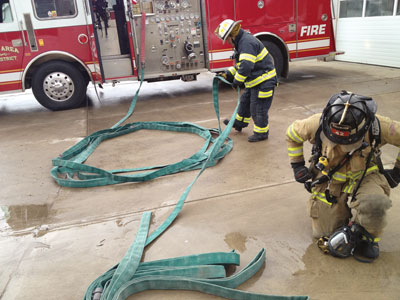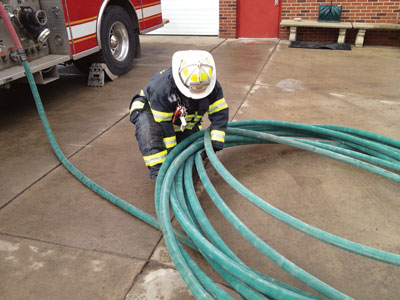
Tim-Bits: April 2013
Tim Llewellyn
Features Fire Ground TrainingWe’ve all seen it before in photos or videos, and have probably done it too: in a neighbourhood of closely built homes, a firefighter is advancing a 61-metre (200-foot) pre-connected shoulder load from the engine toward a small, residential structure with smoke and flames presenting from one of the back windows.
We’ve all seen it before in photos or videos, and have probably done it too: in a neighbourhood of closely built homes, a firefighter is advancing a 61-metre (200-foot) pre-connected shoulder load from the engine toward a small, residential structure with smoke and flames presenting from one of the back windows. The incident commander has called for an interior attack. The truck company is opening up the front door and is preparing to make entry for search operations. The back-up firefighter on the hoseline clears the remaining 30 metres (100 feet) of the attack line from the hose bed, stretching and flaking it toward the house. The nozzle firefighter, with the hose on his shoulder, is walking up and down the small front yard of the home, between the curb and the front porch. He is flaking the shoulder load onto the ground for what he thinks will be an effective and easy stretch. The department’s operating guidelines call for all hoselines to be charged prior to entry, so at the front door, the nozzle firefighter and the back-up firefighter, now masked up and ready to go, indicate for the pump operator to charge their line. Everything seems to be going just fine.
Quickly, the nozzle firefighter opens the nozzle to bleed the air from the line and then checks the stream selection to ensure it’s on a straight-stream pattern. The two firefighters indicate their readiness to one another, and they enter the structure. About 10 metres into the residence, in the back hallway, they meet up with the truck company members, who tell them the fire is behind the bedroom door that they are holding closed. The nozzle firefighter gets in position and turns the stream selector to the right one last time while the truck company radios to the incident commander, telling of both teams’ progress. The truck firefighter opens the door and the nozzle firefighter opens the bail, expecting a good strong stream of water. After only a quick burst, the hose goes limp. The back-up firefighter chases the length of the hose back out the front door and finds that at every bend in the hose stretch outside, there is a kink. The firefighter’s stress level goes up a few notches as he struggles to undo the kinks in the remaining hose in the small front yard.
 |
|
| Photo 1: As the nozzle firefighter prepares to make entry, the back-up firefighter flakes the hoseline using the loop method: large loops are made with the hose, starting from the back of the hose toward the nozzle. This makes for a virtually kink-free advance. |
|
 |
|
| Photo 2: If any kinks remain in the hose after it is charged to full pressure, they can easily be undone by one firefighter picking up the pile of loops and shaking, or fluffing, the pile.PhotoS by Tim Llewellyn |
The problem is simple: there is a lot of hose to flake out and not a lot of room in which to do it. There are many solutions to this problem. I have found that the loop method is the best way to help eliminate kinks in shoulder-loaded hoselines in tight quarters.
The technique is fairly simple and works best with shoulder-loaded or Minuteman-style hose loads. The nozzle firefighter and the back-up firefighter shoulder both the lead and the back sections from the apparatus and advance them toward the flaking- or hose-staging area as normal.
Once in the staging area, the nozzle firefighter places his shoulder bundle on the ground, attempting to maintain the order of the stack as much as possible.
If the back-up firefighter has any hose left from his shouldered bundle, it should be placed on the ground near the nozzle firefighter’s bundle. The nozzle firefighter then places the nozzle one or two metres away from the bundle(s) in the direction of the advance. Then, starting from the top of the nozzle or the back-up hose bundle (the part of either bundle from where the hose flakes as the firefighter advances), the firefighter makes large loops about 2.5 metres wide on the ground until the nozzle ends up on the top of the pile of loops (see photo 1). It is vitally important that, when creating the loops, you start from the back of the hose and end with the nozzle on top.
This looping task is most easily performed by one firefighter, freeing up the other firefighter to prepare for entry or to perform other important fire-ground tasks. Once the firefighters are prepared to make entry, they must call for the hoseline to be charged to full pressure before they begin their advance. This technique will not work if the hose is left uncharged when advanced, as major kinks will result.
As the looped hose fills, some minor kinks may form in the loops. These kinks can easily be resolved by lifting the pile of loops to waist height and fluffing them up and down a few times (see photo 2). Once the hose is looped and fluffed, it is ready for a kink-free advance.
I have found that this technique also works well with highrise or standpipe hose packs. Instead of flaking the hose up and down the adjoining stairwells, it is all kept on the landing where the standpipe connection is made. I have also found that it advances with less effort and with less chance of snagging a coupling lug on railings or stair treads – which is great for when staffing is low. It also poses less of a trip hazard to firefighters or occupants who might be moving on what could be smoke-obscured stairs.
The loop technique may not be right for every hose advance situation encountered, but it is definitely another tool on which to train and to put into the mental toolbox in the event that a tight-quarters hose stretch is ever needed.
Tim Llewellyn is a career firefighter for the Allegheny County Airport Authority in Pittsburgh, Penn. A volunteer firefighter since 1989, he currently serves for the Adams Area Fire District in Pennsylvania. He has recently been appointed as a suppression-level instructor for the Pennsylvania State Fire Academy. He has taught structural firefighting tactics extensively in Canada and the U.S. E-mail him at llewllyn.fire@gmail.com
Print this page